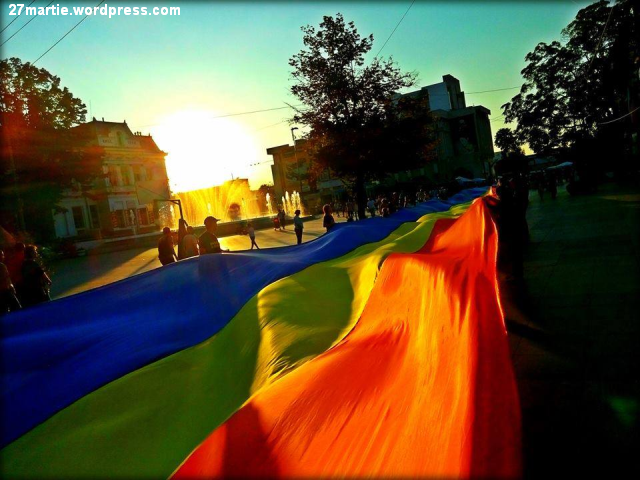The Union of Bessarabia with Romania
On March 27, 1918 the Country's Council, the representative assembly of all Romanians from Bessarabia, voted for the union with the Kingdom of Romania

Steliu Lambru, 03.04.2017, 11:53
In the unstable context of WWI, that was considered a reparation gesture after the occupation of 1812, and it proved to be the best political solution.
Left alone on the eastern front after the withdrawal of Russia from the war, Romania had asked for peace and it had to cope with the occupation of the Central Powers on the one hand, and with the evacuation of the Russian army that was in the grip of the revolutionary fever, on the other hand. Doctor of medicine Daniel Ciugureanu was one of the most fervent supporters of the union of Bessarabia with Romania. His son, Gheorghe Ciugureanu, gave an interview to the Oral History Centre of the Romanian Radio Broadcasting Corporation in 1993, in which he talked about his father. Born into an old family of Moldavian boyars from the region of Hotin, Ciugureanu obtained the title of doctor of medicine at the Kiev University. During his student years he set up a cultural society entitled “The Awakening together with historian Ştefan Ciobanu, writer Alexe Mateevici, engineer Nicolae Codreanu and other nationalists.
In 1993 Gheorghe Ciugureanu recollected what his father had told him about the political membership of Bessarabia’s Council which had a decisive role in Bessarabia’s union with Romania: “In 1917 he participated in the setting up of the Country’s Council, that is the Parliament of the former Moldovan Republic, which sat for the first session on November 25, 1917. In the session of November 27, 1917 they proclaimed the autonomy of the Democratic Moldovan Republic which however remained a part of the Russian Empire. The Country’s Council was made up of two main political factions, besides several other less significant factions based on ethnicity such as the Union of Germans, the Union of Gagauz People, the Union of Jews, of Ukrainians and Poles. The two main factions were the so-called Peasants’ Group led by Ion Inculet who was helped by Pantelimon Erhan and Pantelimon Halippa, and the Moldovan Bloc, the other faction that militated for the autonomy of Bessarabia, which however, remained part of the Russian Empire. The Moldovan Bloc was headed by Daniel Ciugureanu who was helped by Buzdugan, Anton Crihan, Stefan Holban, Dimitrie Bogoz and many others.
The union was not an easy process, although many people of Bessarabia were animated by nationalist convictions. The period of anarchy that followed the coming to power of the Soviet army in Petrograd caused a lot of trouble.
Gheorghe Ciugureanu: “In a first phase, the power was in the hands of the Peasants’ faction, Ion Inculet was elected president of the Country’s Council, the parliament, while the government was headed by Pantelimon Erhan whose actions were somehow coordinated by the central government in Petrograd. This first phase lasted from the first session of November 25, 1917 until January 14, 1918. During this period, and before the Country Council was established, the number of Russian defectors from the Moldovan front increased substantially, as a result of the Revolution that had started in Russia. On their way to the country, these defecting soldiers crossed Bessarabia, plundering and killing people, not without help from the local thugs. The situation had become intolerable, because these groups were manipulated by the peoples commissars into hunting down the leaders of the Romanian patriotic movement. This is how my Godfather Simion Gurafa was murdered. He was killed on the estate of Hodorogea, another high-profile Romanian patriot, by a gang of defecting soldiers. My father had to go into hiding at that point, because otherwise he would have been one of the first victims, without doubt.
Facing the evident threat of total destruction, the leaders of the Bessarabian movement requested the support of the Romanian Army to restore order. However, the actions of the Romanian Army were not met without protests.
Gheorghe Ciugureanu: “The crisis was at its peak. In early January 1918, volunteers from Transylvania, who had come to Bessarabia to help the locals fight those gangs, were massacred in the Chisinau rail station. As a result, a secret meeting was organised by the leaders of the Moldovan Bloc, which was in Opposition at that time. The meeting was held in the house of engineer Nicolae Codreanu and chaired by my father. A decision was made at that meeting to send envoys to Iasi, where the Government of Romania was temporarily headquartered, and to request the help of the Romanian Army in order to put an end to the killings and plundering. The envoys of the Moldovan Bloc reached Iasi, handed their request for a unit of the Romanian Army, and the result was immediate. The very next day, although with great sacrifice, a unit of the Romanian Army, which had been fighting on the Carpathian line, was deployed to Bessarabia under the command of General Ernest Brosteanu. The troops reached Bessarabia around January 9, so it actually crossed the River Prut in three days and headed for Chisinau. This is when a completely unexpected thing happened. The Country Council, which was the government of Bessarabia at that time, sent a protest telegram to the Government of Romania in Iasi. The telegram was signed by Ion Inculet and countersigned by Pantelimon Erhan, the head of government, and it protested in rather vigorous terms the entry of the Romanian Army into Bessarabia.
Although not seen with a friendly eye by all Bessarabians at first, it was the union with Romania of March 1918 which brought peace to this territory after 4 years of bloodshed. (Translated by L. Simion and AM Popescu)





























